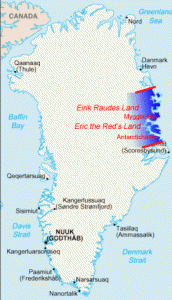Greenland
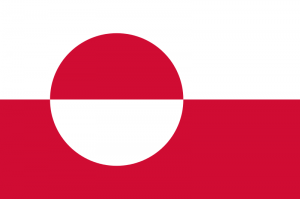
The Lost Vikings
The west coast of Greenland was the site of a thriving Viking colony for hundreds of years. Originally settled by explorers who had bravely sailed across the treacherous North Atlantic from their homes in Scandinavia, the Greenland outpost grew into a farming community of thousands. And then something went terribly wrong. Visitors in the 1400’s reported that the inhabitants had simply vanished, leaving no bodies and few clues about what could have happened. Speculation has long centered on suddenly adverse weather conditions or possibly a war with local Inuit people, but in this documentary, an installment of PBS’s Secrets of the Dead set, a team of archaeologists, forensic anthropologists, and botanists visit a desolate and remote stretch of the Greenland coast and solve the mystery of the lost Vikings. The archaeological record, combined with the scant written accounts of how the settlers lived, begin to reveal some surprising evidence. And a complicated story involving a “mini ice age” emerges. The compelling theory indicates that worsening conditions, coupled with strict religious beliefs that kept the Greenland Vikings from adapting by learning the ways of the natives, sealed their fate. This is a captivating look at a little-known mystery. –Robert J. McNamara.
Greenland (Greenlandic: Kalaallit Nunaat [kaˈlaːɬit ˈnunaːt]) is an autonomouscountry within the Kingdom of Denmark, located between the Arctic and Atlantic Oceans, east of the Canadian Arctic Archipelago. Though physiographically a part of the continent of North America, Greenland has been politically and culturally associated with Europe (specifically Norway and later Denmark) for more than a millennium. In 2008, the people of Greenland passed a referendum supporting greater autonomy; 75% of votes cast were in favour. Greenland is, in terms of area, the world’s largest island, over three-quarters of which is covered by the only contemporary ice sheet outside of Antarctica. With a population of 56,370 (2013), it is the least densely populated country in the world.
Greenland has been inhabited off and on for at least the last 4,500 years by Arctic peoples whose forebears migrated there from Canada. Norsemen settled on the uninhabited southern part of Greenland beginning in the 10th century. Inuit peoples arrived in the 13th century. The Norse colonies disappeared in the late 15th century. In the early 18th century, Scandinavia and Greenland came back into contact with each other, and Denmark established sovereignty over the island.
Having been ruled by Denmark–Norway for centuries, Greenland (Danish:Grønland) became a Danish colony in 1814, and a part of the Danish Realm in 1953 under the Constitution of Denmark. In 1973, Greenland joined the European Economic Community with Denmark. However, in a referendum in 1983, a majority of the population voted for Greenland to withdraw from the EEC, and Greenland officially withdrew in 1985. In 1979, Denmark granted home rule to Greenland, and in 2008, Greenlanders voted in favour of the Self-Government Act which transferred more power from the Danish royal government to the local Greenlandic government. Under the new structure, in effect since 21 June 2009, Greenland can gradually assume responsibility for policing, judicial system, company law, accounting and auditing; mineral resource activities; aviation; law of legal capacity, family law and succession law; aliens and border controls; the working environment; and financial regulation and supervision. The Danish government retains control of foreign affairs and national defence. It also retains control of monetary policy, providing an initial annual subsidy of DKK3.4 billion, slated to diminish gradually over time as Greenland’s economy is strengthened by increased income from the extraction of natural resources.
Etymology
It was the early Scandinavian settlers who gave the country the nameGreenland. In the Icelandic sagas, it is said that the Norwegian-born Icelander Erik the Red was exiled from Iceland for murder. Along with his extended family and his thralls, he set out in ships to explore icy land known to lie to the northwest. After finding a habitable area and settling there, he named it Grœnland (translated as “Greenland”), supposedly in the hope that the pleasant name would attract settlers.
The name of the country in Greenlandic (Kalaallisut) is Kalaallit Nunaat (“land of the Kalaallit”). The Kalaallit are the indigenous Greenlandic Inuit people who inhabit the country’s western region.

Early Paleo-Eskimo Cultures
In prehistoric times, Greenland was home to several successive Paleo-Eskimo cultures known primarily through archaeological finds. The earliest entry of the Paleo-Eskimo into Greenland is thought to have occurred about 2500 BC. From around 2500 BC to 800 BC, southern and western Greenland was inhabited by the Saqqaq culture. Most finds of Saqqaq-period archaeological remains have been around Disko Bay. From 2400 BC to 1300 BC, the Independence I culture existed in northern Greenland. It was a part of the Arctic small tool tradition. Towns, including Deltaterrasserne, started to appear.
Around 800 BC, the Saqqaq culture disappeared and the Early Dorset culture emerged in western Greenland and the Independence II culture in northern Greenland. The Dorset culture was the first culture to extend throughout the Greenlandic coastal areas, both on the west and east coasts, and it lasted until the total onset of the Thule culture in 1500 AD. The Dorset culture population lived primarily from whale hunting. The Thule culture people are the ancestors of the current Greenlandic population. They started migrating from Alaska around 1000 AD, reaching Greenland around 1300 AD. The Thule culture was the first to introduce to Greenland such technological innovations as dog sleds and toggling harpoons.
Norse Settlement
From 986 AD, Greenland’s west coast was settled by Icelanders and Norwegians in two settlements on fjords near the southwestern-most tip of the island. They shared the island with the late Dorset culture inhabitants who occupied the northern and western parts, and later with the Thule culture arriving from the north. Norse Greenlanders submitted to Norwegian rule in the 13th century, and the kingdom of Norway entered into a personal union with Denmark in 1380, and from 1397 was a part of the Kalmar Union.
The settlements, such as Brattahlíð, thrived for centuries but disappeared sometime in the 15th century, perhaps at the onset of the Little Ice Age. Apart from some runic inscriptions, no contemporary records or historiography survives from the Norse settlements. Icelandic saga accounts of life in Greenland were composed in the thirteenth century and later, and do not constitute primary sources for the history of early Greenland. Modern understanding therefore depends on the physical data. Interpretation of ice core and clam shell data suggests that between 800 and 1300 AD, the regions around the fjords of southern Greenland experienced a relatively mild climate several degrees Celsius higher than usual in the North Atlantic, with trees and herbaceous plants growing and livestock being farmed. Barley was grown as a crop up to the 70th parallel. What is verifiable is that the ice cores indicate Greenland has experienced dramatic temperature shifts many times over the past 100,000 years. Similarly the Icelandic Book of Settlements records famines during the winters in which “the old and helpless were killed and thrown over cliffs.” (Arnold 2010)
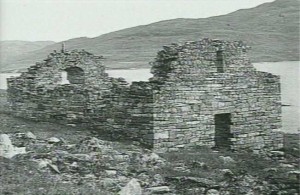 The last written records of the NorseGreenlanders are of a marriage in 1408 in the church of Hvalsey—today the best-preserved Nordic ruins in Greenland.
The last written records of the NorseGreenlanders are of a marriage in 1408 in the church of Hvalsey—today the best-preserved Nordic ruins in Greenland.
These Icelandic settlements vanished during the 14th and 15th centuries, probably as a result of famine and increasing conflicts with the Inuit. The condition of human bones from this period indicates that the Norse population was malnourished, probably due to soil erosion resulting from the Norsemen’s destruction of natural vegetation in the course of farming, turf-cutting, and wood-cutting, pandemic plague, a decline in temperatures during the Little Ice Age, and armed conflicts with the Inuit.
1500–1814
In 1500, King Manuel I of Portugal sent Gaspar Corte-Real to Greenland in search of a Northwest Passage to Asia which, according to the Treaty of Tordesillas, was part of the Portuguese area of influence. In 1501, Corte-Real returned with his brother, Miguel Corte-Real. Finding the sea frozen, they headed south and arrived in Labrador and Newfoundland. Upon the brothers’ return to Portugal, the cartographic information supplied by Corte-Real was incorporated into a new map of the world which was presented to Ercole I d’Este, Duke of Ferrara, by Alberto Cantino in 1502. The Cantino planisphere, made in Lisbon, accurately depicts the southern coastline of Greenland.
In 1605–1607, King Christian IV of Denmark sent a series of expeditions to Greenland and Arctic waterways to locate the lost eastern Norse settlement and assert Danish sovereignty over Greenland. The expeditions were mostly unsuccessful, partly due to leaders who lacked experience with the difficult arctic ice and weather conditions, and partly because the expedition leaders were given instructions to search for the Eastern Settlement on the east coast of Greenland just north of Cape Farewell, which is almost inaccessible due to southward drifting ice. The pilot on all three trips was English explorer James Hall.
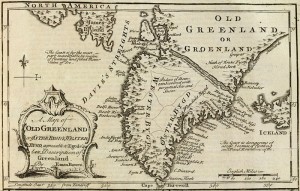 A 1747 map based on Egede’s descriptions and misconceptions.
A 1747 map based on Egede’s descriptions and misconceptions.
After the Norse settlements died off, the area came under the de facto control of various Inuit groups, but the Danish government never forgot or relinquished the claims to Greenland that it had inherited from the Norwegians; and when contact with Greenland was re-established in the early 18th century, Denmark asserted its sovereignty over the island. In 1721, a joint mercantile and clerical expedition led by Danish-Norwegian missionary Hans Egede was sent to Greenland, not knowing whether a Norse civilization remained there. The expedition can be seen as part of the Danish colonization of the Americas. After 15 years in Greenland, Hans Egede left his son Paul Egede in charge of the mission in Greenland and returned to Denmark where he established a Greenland Seminary. This new colony was centred at Godthåb (“Good Hope”) on the southwest coast. Gradually, Greenland was opened up to Danish merchants, and closed to those from other countries.
Treaty of Kiel to World War II
When the union between the crowns of Denmark and Norway was dissolved in 1814, the Treaty of Kiel severed Norway’s former colonies and left them under the control of the Danish monarch.
Norway occupied then-uninhabited eastern Greenland as Erik the Red’s Land in July 1931, claiming that it constituted terra nullius. Norway and Denmark agreed to submit the matter in 1933 to the Permanent Court of International Justice, which decided against Norway.
Greenland’s connection to Denmark was severed on 9 April 1940, early in World War II, when Denmark was occupied by Nazi Germany. On 8 April 1941, the United States occupied Greenland to defend it against a possible invasion by Germany. The United States occupation of Greenland continued until 1945. Greenland was able to buy goods from the United States and Canada by selling cryolite from the mine at Ivittuut. The major air bases were Bluie West-1 at Narsarsuaq and Bluie West-8 at Søndre Strømfjord (Kangerlussuaq), both of which are still used as Greenland’s major international airports. During this war, the system of government changed: Governor Eske Brun ruled the island under a law of 1925 that allowed governors to take control under extreme circumstances; Governor Aksel Svane was transferred to the United States to lead the commission to supply Greenland. The Danish Sirius Patrol guarded the northeastern shores of Greenland in 1942 using dogsleds, detecting several German weather stations and alerting American troops who then destroyed them. After the collapse of the Third Reich, Albert Speer briefly considered escaping in a small aeroplane to hide out in Greenland, but changed his mind and decided to turn himself in to the United States Armed Forces.
Greenland had been a protected and very isolated society until 1940. The Danish government had maintained a strict monopoly of Greenlandic trade, allowing only small scale troaking with Scottish whalers. Nevertheless, wartime Greenland developed a sense of self-reliance through self-government and independent communication with the outside world. Despite this change, in 1946 a commission including the highest Greenlandic council, the Landsrådene, recommended patience and no radical reform of the system. Two years later, the first step towards a change of government was initiated when a grand commission was established. A final report (G-50) was presented in 1950: Greenland was to be a modern welfare state with Denmark as sponsor and example. In 1953 Greenland was made an equal part of the Danish Kingdom. Home rule was granted in 1979.
Home rule and Self-Rule
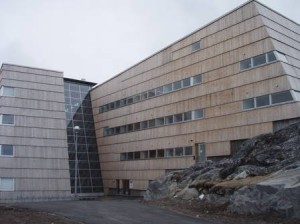 The orthography and vocabulary of the Greenlandic language is governed byOqaasileriffik, the Greenlandic language secretariat, located in the Ilimmarfikuniversity Campus in Nuuk.
The orthography and vocabulary of the Greenlandic language is governed byOqaasileriffik, the Greenlandic language secretariat, located in the Ilimmarfikuniversity Campus in Nuuk.
Following World War II, the United States developed a geopolitical interest in Greenland, and in 1946 the United States offered to buy Greenland from Denmark for $100,000,000, but Denmark refused to sell. However, in 1950, Denmark did agree to allow the United States to reestablish Thule Air Base, which was greatly expanded between 1951 and 1953 as part of a unified NATO Cold War defence strategy. The local population of three nearby villages was moved over 100 kilometres away in the winter. A secret attempt to construct a subterranean network of nuclear missile launch sites in the Greenlandic ice cap named Project Iceworm was carried out from Camp Century from 1960 to 1966 before being abandoned as unworkable. The Danish government did not become aware of the programme’s actual mission until 1997, when it was discovered while looking for records related to the crash of a nuclear-equipped B-52 bomber at Thule in 1968.
With the 1953 Danish constitution, Greenland’s colonial status ended as the island was incorporated into the Danish realm as an amt (county), also extending Danish citizenship to Greenlanders. This also resulted in a change in Danish policies toward Greenland that consisted of a strategy of cultural assimilation—or de-Greenlandification. During this period, the Danish government promoted the exclusive use of Danish in official matters, and required Greenlanders to go to Denmark for their post-secondary education; many Greenlandic children grew up in boarding schools in southern Denmark, many losing their cultural ties to Greenland. While the policies “succeeded” in the sense of creating a demographic shift turning Greenlanders from being primarily subsistence hunters into being urbanized wage earners, the policy also backfired to produce a reassertion of Greenlandic cultural identity by the Greenlandic elite, leading to a movement in favour of independence that reached its peak in the 1970’s. As a consequence of political complications in relation to Denmark’s entry into the European Common Market in 1972, a further desire to establish the legality of Greenland’s status formed in Denmark, resulting in the Home Rule Act of 1979, which gave Greenland limited autonomy with its own legislature taking control of some internal policies, while the Parliament of Denmark maintained full control of external policies, security, and natural resources. The law came into effect on 1 May 1979. The Queen of Denmark, Margrethe II, remains Greenland’s Head of state. In 1985, Greenland left the European Economic Community (EEC) upon achieving self-rule, in view of the EEC’s commercial fishing regulations and an EEC ban on seal skin products. A referendum on greater autonomy was approved on 25 November 2008.
On 21 June 2009, Greenland assumed self-determination with responsibility for self-government of judicial affairs, policing, and natural resources. Also, Greenlanders were recognized as a separate people under international law. Denmark maintains control of foreign affairs and defence matters. Denmark upholds the annual block grant of 3.2 billion Danish kroner, but as Greenland begins to collect revenues of its natural resources, the grant will gradually be diminished. It is considered by some to be a step toward eventual full independence from Denmark. Greenlandic became the sole official language of Greenland at the historic ceremony.


